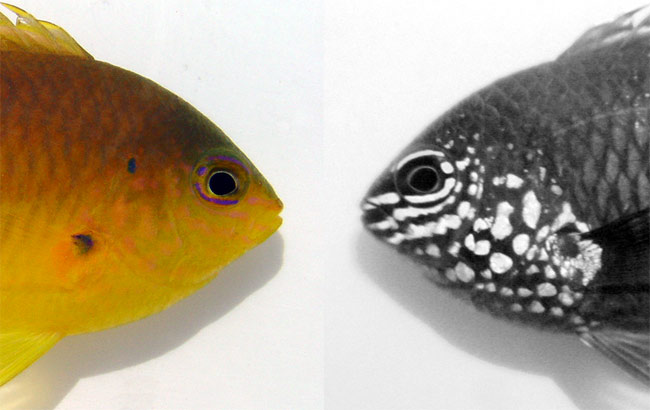Fish Use UV Light to Distinguish Faces

While we might use eye color and hairstyle to tell people apart, some fish species rely on ultraviolet light patterns of faces to distinguish one species from another, a new study finds.
Scientists have long known some animals have UV vision, with the ability to see those wavelengths on the electromagnetic spectrum that are shorter than visible light. But they hadn't realized just how savvy some of these ultraviolet peepers were. (Humans are essentially colorblind in UV.)
The researchers studied two species of damselfish, which are small, aggressive fish that would look identical to us. They placed a male fish from each species, Ambon damselfish (Pomacentrus amboinensis) and lemon damselfish (P. moluccensis), into plastic tubes and presented these to a territory owner, a male Ambon damselfish, in its natural reef habitat.
Twenty-two of the 28 territory owners preferred to attack intruders from their own species rather than the foreigners. When the experiment was run with UV filters so the fish couldn't see the UV facial patterns, this same preference for attacking kin wasn't found.
It makes sense they would attack one of their own. "The highest level of competition is expected from members of the own species," said Ulrike Siebeck of the University of Queensland in Australia.
The results held even though individual fish within each species showed slightly different UV patterns. And so there seems to be an overall pattern the fish use to pick out one species from another, Siebeck figures.
For instance, the lemon damselfish showed more UV reflective "spots," but on average each of these components had a smaller area than those found in Ambon damselfish.
Sign up for the Live Science daily newsletter now
Get the world’s most fascinating discoveries delivered straight to your inbox.
"We don’t know yet which features are used by the fish but these results show that it is possible to find systematic differences between the two species," Siebeck said.
Siebeck suspects the fish might use these individual differences to tell apart one fish from the group even within the same species.
"The individual differences could code for all sorts of things that might be useful information for the fish – fitness, hierarchical status, maybe willingness to fight," Siebeck told LiveScience. "We are testing this at the moment … and so far it is looking good."
The results will be published in the March 9 issue of the journal Current Biology.
- Images: Freaky Fish
- Top 10 Animal Senses Humans Don't Have
- Images: Rich Life Under the Sea
Jeanna Bryner is managing editor of Scientific American. Previously she was editor in chief of Live Science and, prior to that, an editor at Scholastic's Science World magazine. Bryner has an English degree from Salisbury University, a master's degree in biogeochemistry and environmental sciences from the University of Maryland and a graduate science journalism degree from New York University. She has worked as a biologist in Florida, where she monitored wetlands and did field surveys for endangered species, including the gorgeous Florida Scrub Jay. She also received an ocean sciences journalism fellowship from the Woods Hole Oceanographic Institution. She is a firm believer that science is for everyone and that just about everything can be viewed through the lens of science.










